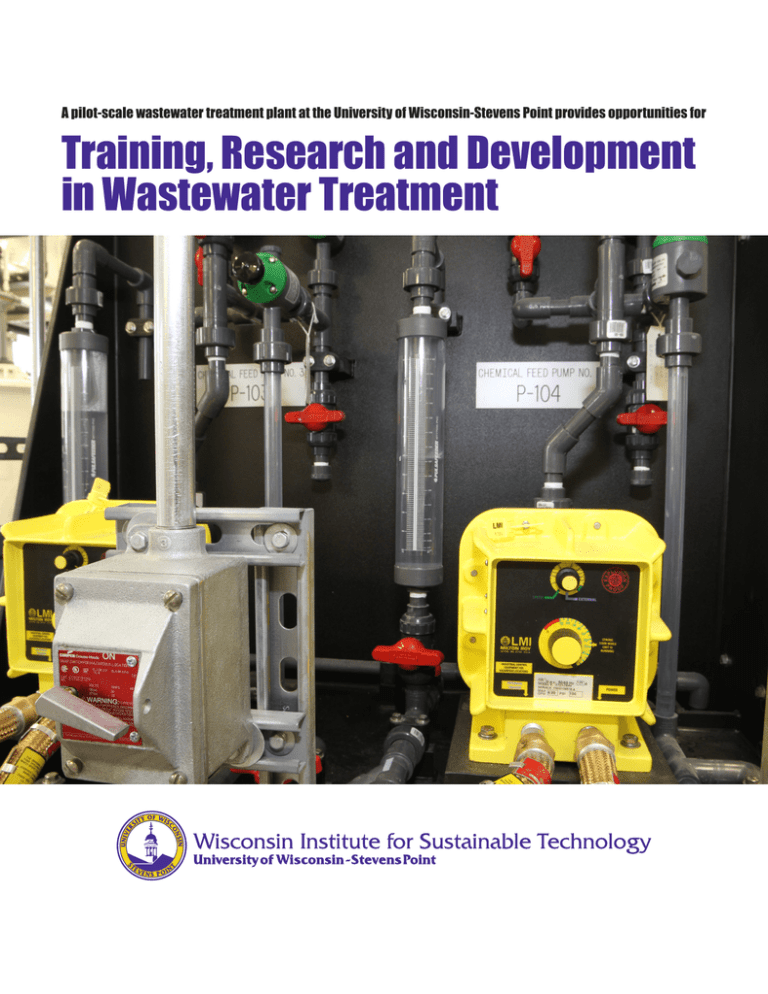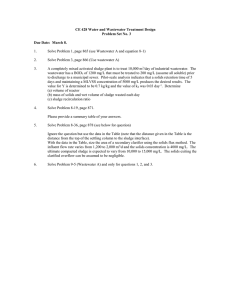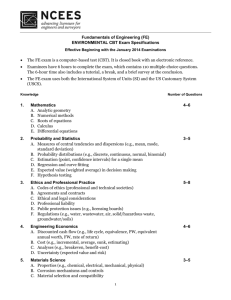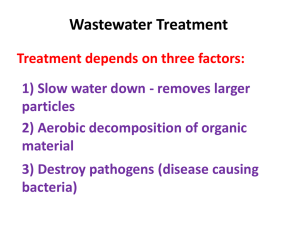Document 11785708
advertisement

A pilot-scale wastewater treatment plant at the University of Wisconsin-Stevens Point provides opportunities for Training, Research and Development in Wastewater Treatment Facility offers research and training opportunities The Waste Education Center at the University of Wisconsin-Stevens Point contains a working wastewater treatment plant with state-of-theindustry technology, the same processes and technology used in municipal wastewater treatment plants across the United States. The facility is managed by the Wisconsin Institute for Sustainable Technology (WIST), a unit within the UW-Stevens Point College of Natural Resources. In addition to its use as a classroom and laboratory for UW-Stevens Point courses in the Soil and Waste Resources Discipline, this center is an excellent training facility for treatment plant operators, engineers, environmental compliance officers and others who may have a need to understand wastewater treatment processes. The waste education center is also used by WIST to provide research and laboratory services for business and industry. (Left) Excess sludge may be pumped to settling tanks and then to digestors. Activated sludge system This plant uses a biological treatment known as activated sludge. Wastewater is pumped into aeration tanks containing microorganisms, which use organic material in the wastewater as food. As the microorganisms break down the organic material, they multiply and form clumps of active masses of microbes and stable solids, called activated sludge. Air is injected continuously into the system to mix the activated sludge with the wastewater and to provide oxygen needed by the microbes. This combination of activated sludge and wastewater is called mixed liquor. The mixed liquor moves to clarifying tanks where the activated sludge settles out and clean water exits the system. Most of the settled sludge is pumped back to the aeration basins to keep the microbe population adequate. Excess sludge may be pumped to sludge settling tanks and from there to digestors. The aeration tanks in the pilot treatment plant feature a series of baffles, so that part of a tank may be run with air and other portions of the tank run without air. Because the treatment plant is designed with two parallel systems, it is possible to run different simulations at the same time. Chemical additions The pilot plant includes six pumps capable of adding different chemicals to the process. For example, in a classroom simulation, a pump may add molasses to simulate wastewater organic compounds to provide additional nutrients to the microorganisms in the tanks. These pumps may be used to add specific chemicals to be tested in the treatment process. Training opportunities: • • • • Municipal wastewater system operators Industrial wastewater system operators Engineers Environmental compliance personnel Research and Development • Understanding the biodegradability profile of compounds during wastewater treatment • Testing of treatment technology prototypes (Bottom) Aeration tanks contain microorganisms, which use organic material in the wastewater as food. A laboratory at the Waste Education Center provides space for bench-top trials. The plant features a touch-screen control panel, where adjustments can be made without entering the wastewater processing area. Technical specifications • • • • Two independent parallel systems may be run separately or mixed Continuous aeration Two aeration tanks, 2.5’ x 8’ x 12’: 1,800 gallon capacity Each aeration tank equipped with baffles so that a portion of the tank may be run with air and other parts without air • Two clarifying tanks, 2.5’diameter by 10’ height: 350 gallon capacity • Wastewater flow of up to 1.5 gallons per minute The system includes pumps capable of adding chemicals to the process. • Activated sludge recycling at up to 1.5 gallons per minute • Supervisory Control and Data Acquisition Computer (SCADA) gathers and stores information for analysis • Touch screen control • Ultraviolet disinfection system Schematic of UW-Stevens Point pilot wastewater treatment plant Treated water Digestor 1 Digestor 2 Key Sludge Storage 2 6 Baffle Fine bubble diffuser Clarifier 1 Clarifier 2 Aeration Aeration Tank 1 Tank 2 5 Chemical Feed Pumps 1 Wastewater 1 Sludge Storage 1 4 3 2 Wastewater 2 The Wisconsin Institute for Sustainable Technology — Creating sustainability solutions and economic opportunities WIST offices and labs are in the Science Building and the Dan Trainer Natural Resources Building on the UW-Stevens Point campus. Online: www.uwsp.edu/wist Direct mail to: University of Wisconsin-Stevens Point Wisconsin Institute for Sustainable Technology 800 Reserve Street Stevens Point, WI 54481-3897 To discuss how your company or institution might use the UW-Stevens Point Waste Education Center contact: John Baldus, Director of Laboratory Services Wisconsin Institute for Sustainable Technology Email: John.Baldus@uwsp.edu Phone: 715-346-3265 The University of Wisconsin-Stevens Point is an Equal Opportunity/ Affirmative Action Institution. Ed. 2: 04/2014






